I. City Impression: A Radiant Pearl at the Foothills of Taihang Mountains
一、城市印象:太行山麓的璀璨明珠
Shijiazhuang, the capital of Hebei Province embraced by the Taihang Mountains, is often called “the youngest provincial capital” yet harbors millennia-old civilization codes. As a transitional zone between the North China Plain and the Taihang Mountains, it serves not only as the junction of the Beijing-Guangzhou Railway and Shijiazhuang-Taiyuan Railway but also as the core inheritance site of Yan-Zhao Culture. While high-speed trains zip through the city at 300 km/h, the Song Dynasty bronze Buddha statues on the ancient Zhengding City Wall still whisper in the morning light. This magical interweaving of time and space constitutes Shijiazhuang’s most unique charm.
石家庄,这座被太行山环抱的河北省会,常被称作“最年轻的省会”,却藏着跨越千年的文明密码。作为华北平原与太行山地的过渡带,它既是京广铁路与石太铁路的交汇枢纽,更是燕赵文化的核心传承地。当高铁列车以300公里时速穿城而过时,古城正定城墙上的宋代铜佛仍在晨光中低语,这种时空交织的魔幻感,正是石家庄最独特的魅力。
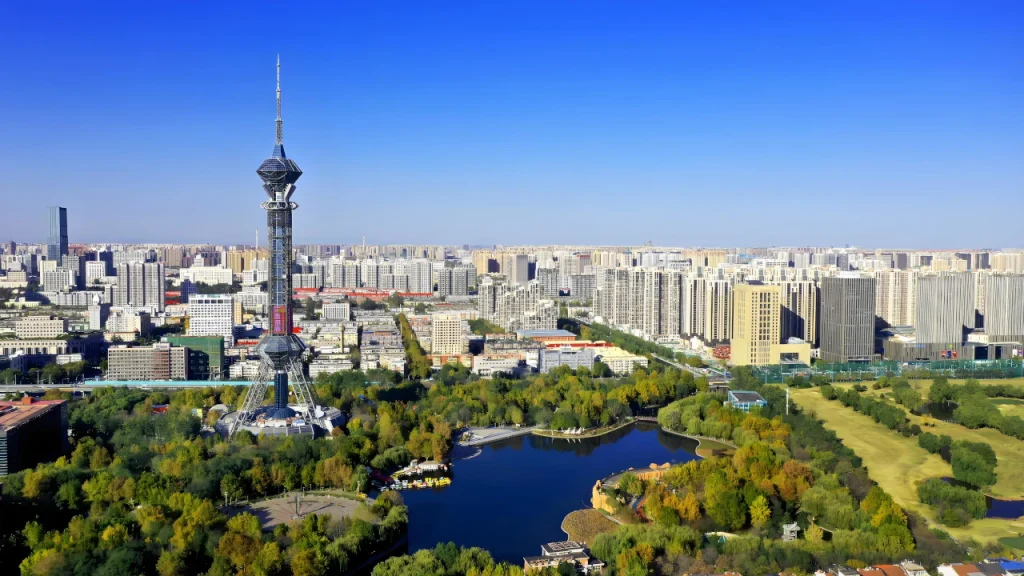
II. Cultural Landmarks Across the Ages
二、历史长河中的文化坐标
Zhengding Ancient City: A Living Fossil of the Three Strategic Passes
正定古城:三关雄镇的活化石
Strolling along the moss-covered brick path of Zhengding’s South Gate, one can almost hear the clash of weapons from ancient battles. Founded during the Northern Zhou Dynasty, this city once stood alongside Baoding and Beijing as the “Three Heroic Towns of the North.” Inside the Longxing Temple, the 21.3-meter-tall Thousand-Hand Avalokitesvara Buddha, cast during the Song Dynasty, glows with soft golden light under the sun. Liang Sicheng once marveled at its “artistic perfection.” In the Rongguo Mansion, filming locations from the 1987 TV adaptation of Dream of the Red Chamber remain intact. On the carved lintel of Grandmother Jia’s courtyard, traces of tape left by the crew still cling like historical whispers.
漫步在正定南城门斑驳的砖道上,仿佛能听见金戈铁马的回声。这座始建于北周的古城,曾与保定、北京并称“北方三雄镇”。隆兴寺内,宋代铸造的千手观音像高21.3米,铜铸的臂膀在阳光下泛着柔和金光,梁思成曾惊叹其为“艺臻极品”。荣国府里,87版《红楼梦》的拍摄场景仍保留着原貌,贾母房前的垂花门楣上,还残留着当年剧组留下的胶带痕迹。
Zhaozhou Bridge: A 1,400-Year-Old Mechanical Marvel
赵州桥:1400年的力学奇迹
The Zhaozhou Bridge over the Xiao River demonstrates ancient craftsmanship through its 37-meter open-spandrel segmental arch. Designed by Li Chun of the Sui Dynasty, its four small arches reduce weight while allowing floodwaters to pass. Locals say that during the “Bridge-Crossing Festival” on the third day of the third lunar month, paper-cut artists create patterns of “Zhang Guolao Riding a Donkey Crossing the Bridge.” Though repaired over time, the “donkey hoof prints” on the bridge deck remain auspicious symbols that children eagerly touch.
洨河上的赵州桥,用37米跨度的空腹式圆弧拱,诠释了古代工匠的智慧。隋代匠师李春设计的四个小腹拱,既减轻了桥身重量,又让洪水有了宣泄之道。当地老人说,每逢农历三月初三“走桥会”,桥畔庙会上的剪纸艺人会剪出“张果老骑驴过桥”的图案,桥面上的“驴蹄印”虽经后世修补,仍是孩童们争相触摸的“吉祥印记”。
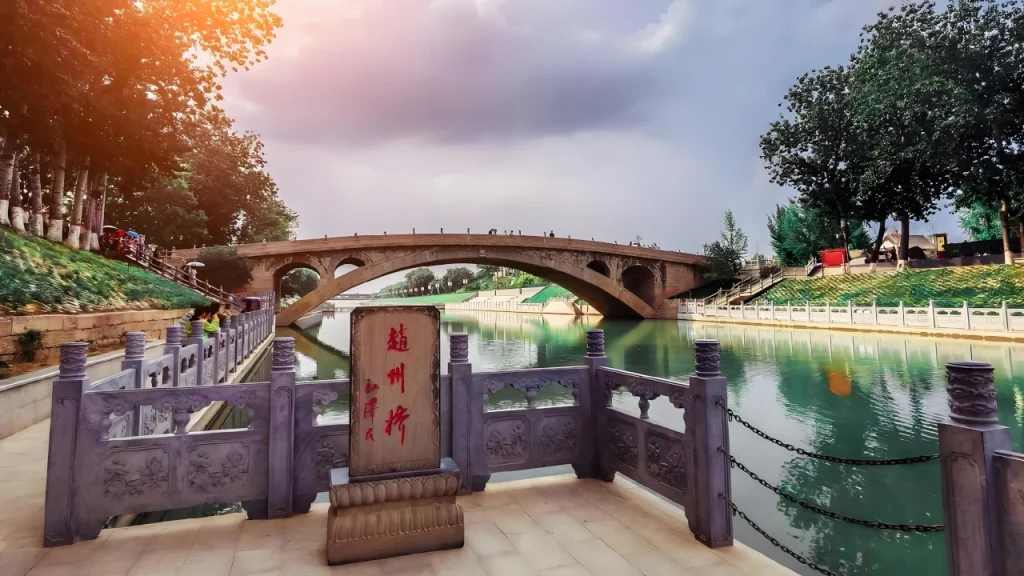
Xibaipo: Where New China Was Born
西柏坡:新中国从这里走来
In Xibaipo, Pingshan County, Mao Zedong used red and blue pencils to mark military maps in adobe houses during 1948, directing the three major campaigns. Today, the Second Plenary Session of the 7th Central Committee site still displays enamel mugs and kerosene lamps on its wooden desk. The handwritten “Working Methods for Party Committees” on the wall retains powerful and incisive strokes, as if carved by history itself.
平山县的西柏坡,1948年的土坯房里,毛泽东用红蓝铅笔在军用地图上圈点,指挥了三大战役。如今,七届二中全会旧址的木桌上,仍摆放着当年使用的搪瓷缸子和煤油灯,墙上的《党委会的工作方法》手迹,字迹遒劲如刀刻。
III. Geographical Code: Survival Wisdom Between Mountains and Rivers
三、地理密码:山水之间的生存智慧
Shijiazhuang’s geographical layout resembles an unfolded Taiji diagram: the western foothills of the Taihang Mountains coil like the Azure Dragon, while the eastern plains stretch out like the White Tiger. Baodu Zhai, standing at 288 meters above sea level, features cliffs as steep as if cleaved by a knife, yet its flat mountaintop once served as Zhang Fei’s military garrison. The Hutuo River meanders through the northern outskirts of the city, where on the “Shijiazhuang-named” cruise ship, locals often fish with homemade rods—this collision of leisurely pace and urban rhythm creates a unique urban tableau.
石家庄的地理版图,恰似一幅展开的太极图:西部太行余脉如青龙蜿蜒,东部平原如白虎平展。海拔288米的抱犊寨,山势陡峭如刀劈,却因山顶平坦如砥,被张飞当作屯兵之所。滹沱河在市区北部蜿蜒而过,河岸的“石家庄号”游轮上,常能看到市民用自制鱼竿垂钓,这种悠闲与都市节奏的碰撞,构成独特的城市景观。
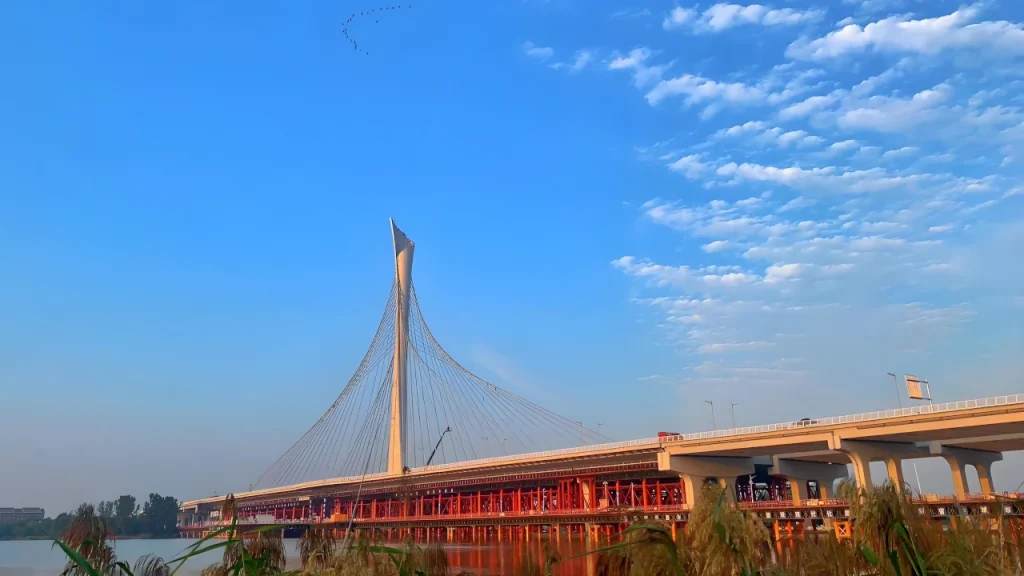
IV. Culinary Journey: A Taste Odyssey from Street Food to Imperial Feasts
四、舌尖上的石家庄:从市井到宫廷的味觉穿越
Zhengding Ma Family Marinated Chicken: A Century-Old Broth Legacy
正定马家卤鸡:百年老汤的馈赠
At Ma Family’s century-old shop on South Yanzhao Street in Zhengding, third-generation heir Ma Hui starts simmering marinade at 5 a.m. daily. Using free-range wood-range chickens and 18 spices including clove and amomum, the chicken slow-cooks for 4 hours in century-old broth. The golden skin shimmers like amber, and a gentle chopstick prod makes the meat unfurl like chrysanthemum petals. Locals pair it with house-made smoked meat stuffed in baked bread, letting the rich gravy drip down their fingers.
在正定燕赵南大街的马家老店,每天清晨五点,第三代传人马辉就会开始熬制卤汤。选用散养柴鸡,配以丁香、砂仁等18味香料,在百年老汤中慢炖4小时。鸡皮金黄透亮,用筷子轻轻一挑,肉丝便如菊花般绽放,当地人习惯配以自制的熏肉火烧,咬一口,卤汁顺着指缝流淌。
Golden-Furred Lion Fish: A Carp’s Culinary Rebirth
金毛狮子鱼:鲤鱼涅槃的视觉盛宴
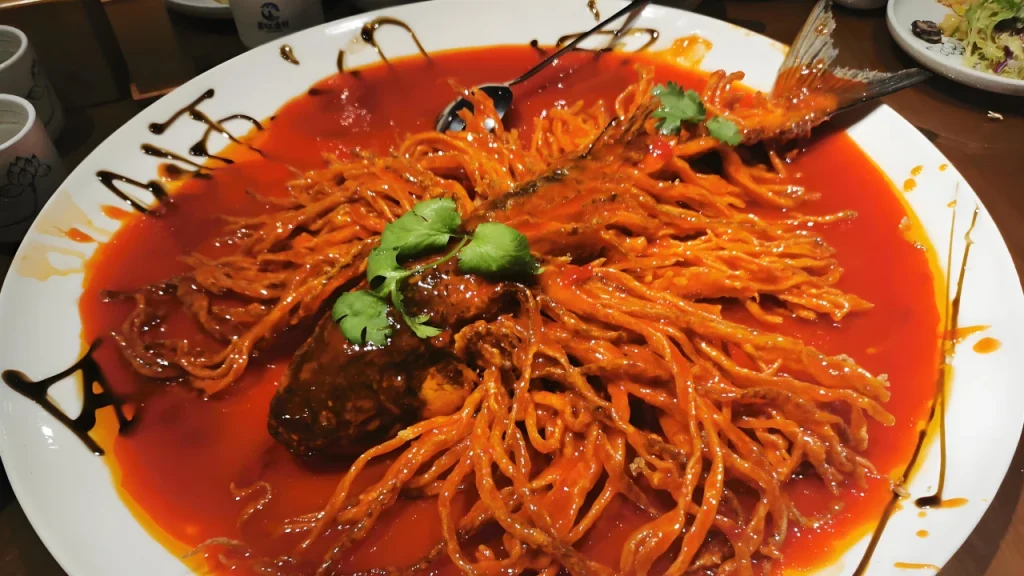
This masterpiece of Hebei cuisine originated in 1950s state-owned restaurants. A 1kg Yellow River carp is deboned and meticulously sliced into thousands of strands, deep-fried to golden puffiness resembling a lion’s mane. Drizzled with sweet-and-sour sauce made of tomatoes, sugar, and vinegar, it balances freshness with tangy sweetness. At Shijiazhuang’s International Hotel revolving restaurant, this dish often serves as the finale for diplomatic banquets.
这道冀菜巅峰之作,源自1950年代国营饭店的创意。选取2斤重的黄河鲤鱼,去骨后改刀成千丝万缕,入油锅炸至金黄蓬松,形似雄狮鬃毛。淋上用番茄、白糖、醋调制的糖醋汁,酸甜中带着河鲜的鲜美。在石家庄国际大厦的旋转餐厅,这道菜常被作为招待外宾的压轴菜。
Clay-Oven Sesame Flatbread: Millennium Dialogue Between Stone and Fire
缸炉烧饼:石与火的千年对话
In Jingxing County’s workshops, artisans still use ancestral methods: dough slapped onto inverted terracotta jars and baked with jujube wood charcoal. Fresh from the oven, the flatbread crackles with honeycomb-like pores. A gentle snap sends crispy layers showering down, releasing a symphony of sesame and wheat aromas. Locals sandwich smoked meat or pickled vegetables inside, washed down with millet congee for the quintessential breakfast.
井陉县的缸炉烧饼作坊,至今保留着最原始的制法:将和好的面贴在倒扣的陶缸内壁,用枣木炭火烘烤。刚出炉的烧饼,表面布满蜂窝状气孔,轻轻一掰,酥皮簌簌掉落,芝麻的香气混着麦香扑鼻而来。当地人喜欢夹上熏肉或咸菜,配一碗小米粥,便是最地道的早餐。
Gaocheng Imperial Noodles: Hair-Thin Secrets from the Palace Kitchen
藁城宫面:细如发丝的宫廷秘技
In Gengjia Village’s workshops, masters adhere to 13 ancient techniques: kneading dough with alkaline saltwater for elasticity, aging it 12 hours in temperature-controlled cellars, then stretching strands to 2 meters using bamboo poles. The hollow, silver-thin noodles absorb broth like sponges. A morning bowl of chicken soup with these noodles represents a century-old wellness tradition for Gaocheng locals.
在藁城耿家庄的宫面作坊,师傅们仍遵循着13道古法工序:和面时加入盐碱水增加筋性,醒面需在恒温地窖中静置12小时,拉丝时用竹竿将面条拉至2米长。成品细如银丝,入锅久煮不烂,空心的面条吸饱汤汁,清晨来一碗鸡汤宫面,是当地人延续百年的养生之道。
V. Themed Tour Recommendations: Five Journeys to Explore
五、深度游推荐:五条主题路线
- Red Memory Tour
红色记忆之旅:
West Hilltop Revolutionary Base (Xibaipo Memorial Hall) → Former Site of the CPC Central Committee → North China Military Region Martyrs’ Cemetery
西柏坡纪念馆→中共中央旧址→华北军区烈士陵园
Highlights: Walk where Mao Zedong plotted major campaigns, explore the adobe houses where the Party’s “March Order” was issued, and pay respects at the tombs of revolutionary martyrs. - Ancient Architecture Quest
古建探秘之旅:
Longxing Temple (Zhengding) → Kaiyuan Temple → Linji Temple → Guanghui Temple Pagoda
正定隆兴寺→开元寺→临济寺→广惠寺华塔
Highlights: Marvel at the Song Dynasty Thousand-Hand Buddha, trace the origins of Linji Chan Buddhism, and admire the Guanghui Temple’s “flower pagoda” with its exquisite brick carvings. - Nature’s Masterpiece Expedition
自然奇观之旅:
Tuoliang Scenic Area (alpine meadows) → Zhangshiyan Geopark (red sandstone cliffs) → Huhui Waterfall (93-meter cascades)
驼梁风景区→嶂石岩地貌→沕沕水瀑布
Highlights: Hike through primeval forests, witness geological wonders formed 1.8 billion years ago, and feel the mist from China’s largest ancient plateau waterfall. - Intangible Heritage Immersion
非遗体验之旅:
Jingxing Lahua Dance (traditional ribbon dance) → Wuji Paper-cutting (32-layer knife skills) → Zhengding Benggan (spicy beef jerky crafting)
井陉拉花表演→无极剪纸工坊→正定崩肝制作
Highlights: Learn the “eight patterns” of Lahua dance, create intricate paper-cuts, and master the 48-hour marination process for this Ming Dynasty-originated snack. - Culinary Discovery Trail
美食寻味之旅:
Jinfeng Braised Chicken (12-hour spice-infused) → Xihe Meat Cake (layered pork & sticky rice) → Guanqia Braised Chicken (medicinal herb stew) → Jingxing Stone-Pressed Wine (3-year aged sorghum liquor)
金凤扒鸡→西河肉糕→管洽焖鸡→井陉实打石酒
Highlights: Taste dishes that blend Huaiyang and Shandong flavors, and experience how local gastronomy evolved from military rations to imperial tributes.
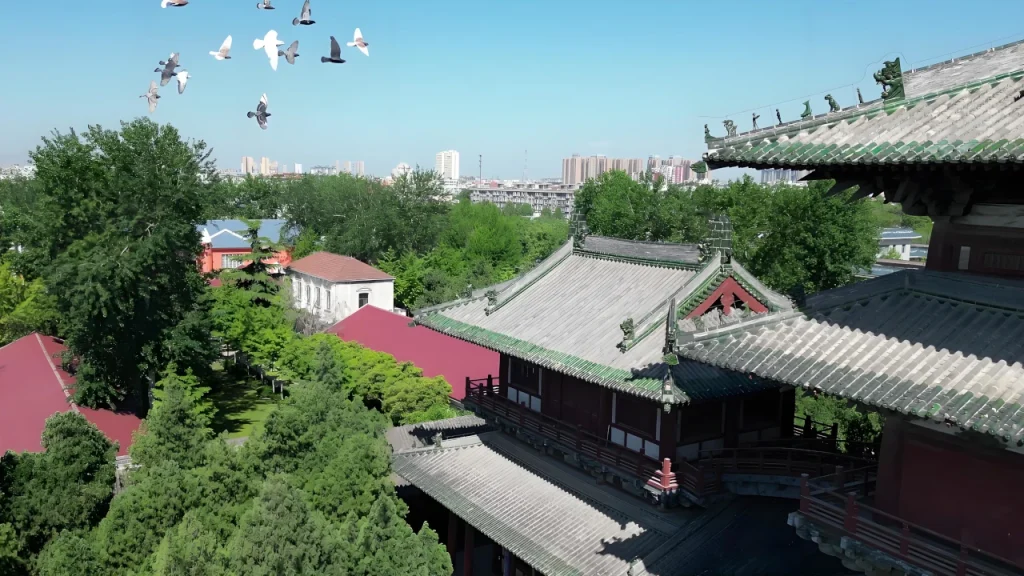
VI. Travel Tips
六、旅行贴士
Optimal Seasons:
最佳季节:
- April-May: When pear blossoms blanket Zhaoxian County’s 417 sq km pear orchards like snowdrifts
- 4-5月梨花盛开时,赵县25万亩梨园如雪海
- September-October: Tuoliang’s mountainsides ignite with a month-long autumnal fire display
- 9-10月驼梁层林尽染,红叶季持续整月
Transportation Guide:
交通建议:
- Metro Line 1 connects downtown Shijiazhuang to Zhengding Ancient City
- 市区至正定古城可乘地铁1号线
- Self-drive recommended for Xibaipo trips (approx. 1-hour drive from city center)
- 至西柏坡建议自驾(全程约1小时)
Unique Experiences:
特色体验:
- Evening Light Show at Zhengding South Gate (nightly 7-9 p.m. during peak season)
- 在正定南门参加“夜游古城”灯光秀
- Birdwatching at Hutuo River Wetland (prime time: 6-8 a.m. for migratory species like Oriental Storks)
- 到滹沱河湿地观鸟(最佳时段清晨6-8点)
As sunset gilts the ramparts of Zhengding Ancient City, as the Xiao River shimmers beneath the Zhaozhou Bridge, and as the aroma of clay-oven flatbread permeates the alleyways, this city—built by railways—narrates its millennium-old Yan-Zhao saga in a unique dialect. Here, history transcends being a sealed specimen; it pulses as genetic code through veins, awaiting every traveler to touch, savor, and inherit.
当夕阳为正定古城墙镀上金边,当赵州桥下的洨河泛起粼粼波光,当缸炉烧饼的香气在巷弄间弥漫,这座被火车拉来的城市,正用它独有的方式讲述着燕赵大地的千年故事。在这里,历史不是尘封的标本,而是融入血脉的基因,等待着每一位旅人去触摸、去品味、去传承。

Leave a Reply